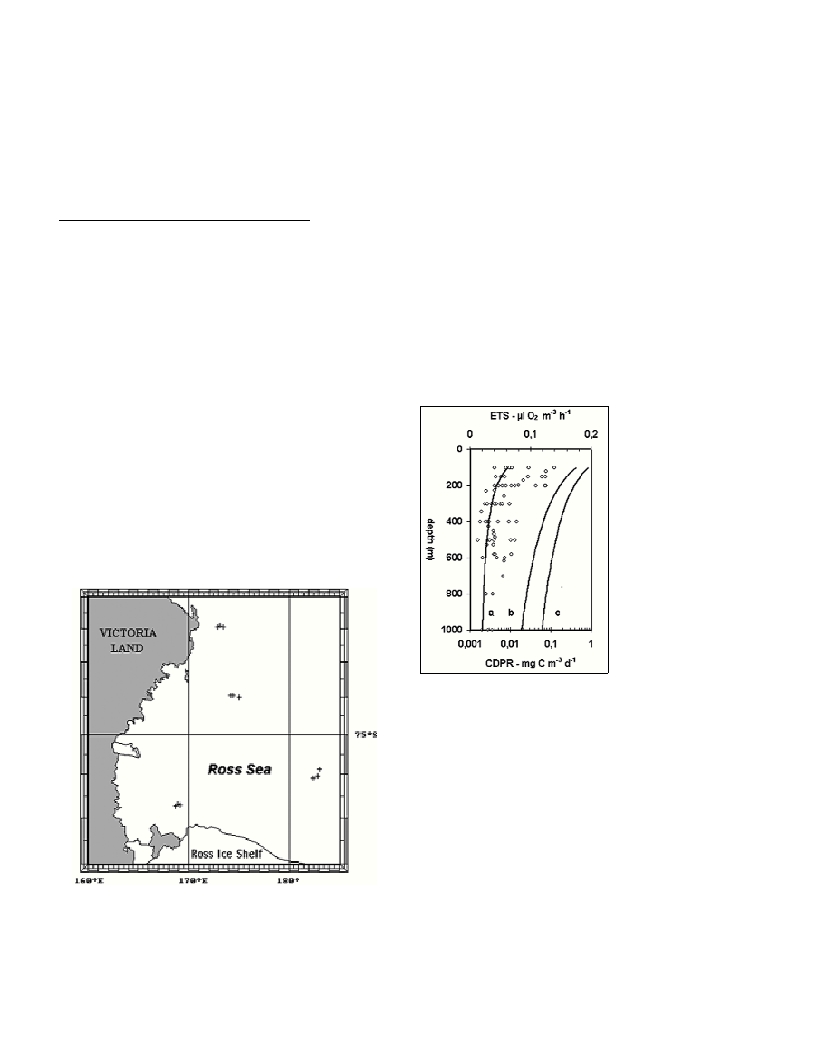DEEP MICROBIAL REMINERALIZATION IN THE ROSS SEA: EVIDENCE FOR POC SOURCE
AS MAIN ORGANIC FUEL OF BIOLOGICAL PUMP.
Azzaro M.*, La Ferla R.
IAMC-CNR, section of Istituto Sperimentale Talassografico, Messina, Italy - *dedalus@ist.me.cnr.it
Abstract
Carbon dioxide production rates (CDPR) of micro-organisms were monitored through their electron transport system (ETS) activity in the
deep Ross Sea. The depth-integrated CDPR amounted to 28,2 mg C m
-2
d
-1
in the depth range 100-1000 m. Comparing CDPR determined
in this study with that obtained by sediment traps in the Ross Sea resulted that about 63% of organic carbon remineralized by respiration
derived from POC pool. Such evidence highlighted POC source as main organic fuel of biological pump in the Ross Sea.
Key-words: Ross Sea, Microplankton, Respiration
Rapp. Comm. int. Mer Médit., 37,2004
169
Introduction
Recent studies have demonstrated that dissolved organic carbon
(DOC) is an important component of the biological pump that
assumed in the deep waters a key role as main organic fuel of
microbial respiration (1, 2). Such evidence seem overturned in the
Southern Ocean, where Wiiebinga and De Baar (3), by estimates of
apparent oxygen utilization and DOC, asserted that DOC pool
accounted for < 10 % of the remineralization in deep waters. Another
study demonstrated (4) that the euphotic zone of the Ross Sea yielded
only a small portion of primary production as DOC (11%), so that
DOC removal by deep convection could be not an important export
term due to the small quantity of DOC that accumulates there.
Furthermore other authors (5) also by sedimet trap studies suggested,
that very little organic remineralization occurred between 250m and
the bottom in the Ross Sea, which implies a rapid delivery and/or
reduced bacterial remineralization.
The purpose of this study was to investigate the supply and
utilization of organic carbon in the aphotic zone of Ross Sea by
evaluation of microplankton respiratory activity and to compare the
vertical carbon balance to different estimates of export production
from the same area and other oceanic regions.
Material and methods
The oceanographic cruise, in the context of the BIOSESO II
project, was carried out from 5 January to 27 February 2001, on board
the R/V Italica (Fig. 1). Microbial respiratory activity (<200µm) was
determined according to the ETS (Electron Transport System) assay
and converted to carbon dioxide production rates (CDPR) using the
factors described in Christensen et al.(1).
Fig. 1. Map of sampling locations.
Results and discussion
The ETS data points versus depth are shown in figure 2 together
with the curves computed for Ross Sea and oceans. Microplankton
ETS activity ranged from 0.012 to 0.139 µl O
2
m
-3
h
-1
on a volume
basis in the layer between 100 and 1000m.
ETS-based CDPR calculated in the Ross Sea, decreased with depth
according to the power function:
CDPR (mg C m
-3
d
-1
) = 0.7207 z
-0.517
,
where z is in meters, r
2
=0.351 and n=73. The depth-integrated CDPR
calculated by the above power function, amounted to 28,2 mg C
m
-2
d
-1
in the depth range 100-1000 m. Our CDPR later summer
estimates were enclose in the range of ETS-derived CDPR
(200-1000m)
(21.8-105.6 mg C m
-2
d
-1
) determined in the Indian sector of Southern
Ocean during early spring (6), but was 2,5 fold lower of their averaged
CDPR.
In figure 2 the curve illustrating the above calculated function, is
compared to those determined in the oceans (1).CDPR calculated in
the Ross Sea were 3 and 7 fold lower than in the Atlantic and Pacific
Oceans, respectively.
Finally comparing CDPR determined in this study with that
obtained by sediment traps in the Ross Sea (5) resulted that about 63%
of organic carbon remin-
eralized by respiration
derived from POC pool.
Such enough large
percentage should be too
higher observing that daily
sediment trap study was
derived from an annual
research while CDPR
study regarded two
months and neglected the
remaining more poor
months of year.
Future studies on
remineralization and the
fate of organic matter of
Ross Sea must primarly
asses the amount of POC
and DOC exported and
oxidized in the deep sea
and furthermore highlight
the relationship between
the very low ?ux of carbon
through the DOC pool in
the euphotic zone and the
very high percentage of
POC pool oxidized in the
aphotic zone as registered in this study.
References
1- Christensen J.P., Packard T.T., Dortch F.Q., Minas H.J., Gascard J.C.,
Richez C., and Garfield P.C., 1989. Carbon oxidation in the deep
Mediterranean sea: evidence for dissolved organic carbon source. Global
Biogeochemical Cycles, 3: 315-335.
2- Lefèvre D., Denis M., Lambert C.E., and Miquel J.C., 1996. Is DOC the
main source of organic matter remineralization in the ocean water
column? Journal Marine Systems, 7: 281-291.
3- Wiebinga C.J., and de Baar H.J.W., 1998. Determination of the
distribution of dissolved organic carbon in the Indian sector of the
Southern Ocean. Marine Chemistry, 61: 185-201.
4- Carlson C.A., Hansell D.A., Peltezer E.T., and Smith W.O.Jr., 2000.
Stocks and dynamics of dissolved and particulate organic matter in the
Southern Ross Sea, Antartica. Deep Sea Research II,47: 3201-3226.
5- Nelson D.M. DeMaster D.J., Dunbar R.B., and Smith W.O.Jr., 1996.
Cycling of organic carbon and biogenic silica in the Southern Ocean:
estimates of large-scale water column and sedimentary ?uxes in the Ross
Sea. Journal Geophysical Research, 101: 18519-18532.
6- Arìstegui J., Denis M., Almunia J., and Montero M.F., 2002. Water-
column remineralization in the Indian sector of the Southern Ocean during
early springDeep Sea Research II,49: 1707-1720.
Fig. 2. ETS versus depth and comparison for
the best-fit functions representing the depth
dependence of CDPR in the Ross Sea (a),
Atlantic Ocean (b) and Pacific Ocean (c).

